Which Type of Kitchen Sink Should I Choose?
If you’re wondering which sink style and material will work in your cookspace, check out this guide to help you decide
There are so many different types of kitchen sink to choose from that it can be confusing to decide which one suits your scheme best. Take a look at this guide to consider the pros and cons of each type to find the best sink material and fitting for your cookspace.
Top-mounted
A popular choice of kitchen sink is the top-mounted, or drop-in, model. The basin is inserted into a pre-cut hole in the worktop, with the edges on show above the surface.
Pros A top-mounted sink is usually cheaper than an under-mounted one, and simpler to install. Your choice of worktop won’t be limited, either, as it works with any type of surface.
Cons The most obvious disadvantage of this type of sink is the exposed edge, where food and debris can get trapped. A good kitchen fitter will seal the edges well to ensure it’s watertight.
A popular choice of kitchen sink is the top-mounted, or drop-in, model. The basin is inserted into a pre-cut hole in the worktop, with the edges on show above the surface.
Pros A top-mounted sink is usually cheaper than an under-mounted one, and simpler to install. Your choice of worktop won’t be limited, either, as it works with any type of surface.
Cons The most obvious disadvantage of this type of sink is the exposed edge, where food and debris can get trapped. A good kitchen fitter will seal the edges well to ensure it’s watertight.
Integrated
It’s possible to create a seamless transition between sink and worktop by going for an integrated basin made from the same material as your kitchen surface. The Corian worktop in this kitchen has been moulded to incorporate a simple square sink.
Pros The seamless design of an integrated sink makes it super-easy to keep clean, as there are no joins where dirt can get trapped. It will also give your kitchen a slick, luxurious feel.
Cons The work involved in creating an integrated sink makes it more expensive than some other designs.
It’s possible to create a seamless transition between sink and worktop by going for an integrated basin made from the same material as your kitchen surface. The Corian worktop in this kitchen has been moulded to incorporate a simple square sink.
Pros The seamless design of an integrated sink makes it super-easy to keep clean, as there are no joins where dirt can get trapped. It will also give your kitchen a slick, luxurious feel.
Cons The work involved in creating an integrated sink makes it more expensive than some other designs.
Which Material?
The material you choose for your sink will depend on the style of your kitchen and the practicality of each surface.
Ceramic
If your style is more traditional than modern, you could go for a ceramic sink in either a Belfast, butler or farmhouse design. Belfast and butler models are narrower than the wide French farmhouse sinks, with Belfast sinks being slightly deeper. This under-mounted model sits above a short cabinet and goes well with the Shaker-style kitchen.
Pros These types of sink are elegant, timeless and hard-wearing, and can be a design feature in themselves. They’re also great if you have large pots and pans to clean, as the basin is generally quite deep.
Cons Ceramic sinks are heavy to install and, if you’re going for an open-fronted model like the one here, you’ll need to design your cabinetry around it. It will also need cleaning frequently, as the white surface will show up stains more than most other materials.
The material you choose for your sink will depend on the style of your kitchen and the practicality of each surface.
Ceramic
If your style is more traditional than modern, you could go for a ceramic sink in either a Belfast, butler or farmhouse design. Belfast and butler models are narrower than the wide French farmhouse sinks, with Belfast sinks being slightly deeper. This under-mounted model sits above a short cabinet and goes well with the Shaker-style kitchen.
Pros These types of sink are elegant, timeless and hard-wearing, and can be a design feature in themselves. They’re also great if you have large pots and pans to clean, as the basin is generally quite deep.
Cons Ceramic sinks are heavy to install and, if you’re going for an open-fronted model like the one here, you’ll need to design your cabinetry around it. It will also need cleaning frequently, as the white surface will show up stains more than most other materials.
Contemporary Belfast and farmhouse sinks come in a double-basin version, too. This top-mounted model is wide and shallow, with two equal sections. Unlike the traditional design, where the tap is fitted into the worktop, this one has a ridged area for the tap to be inserted.
Stainless-steel
Versatile and durable, stainless-steel sinks have been popular in kitchens for decades. They’re available in most styles and the silver surface pretty much goes with any cabinetry.
Pros Stainless-steel sinks are affordable and easy to fit. They’re also incredibly durable, so unless you get bored of the design, your sink should last forever.
Cons Although it’s hard-wearing, stainless-steel is susceptible to scratches, so avoid using abrasive cleaners. If you want a gleaming surface without water stains, wipe your sink dry after cleaning.
Versatile and durable, stainless-steel sinks have been popular in kitchens for decades. They’re available in most styles and the silver surface pretty much goes with any cabinetry.
Pros Stainless-steel sinks are affordable and easy to fit. They’re also incredibly durable, so unless you get bored of the design, your sink should last forever.
Cons Although it’s hard-wearing, stainless-steel is susceptible to scratches, so avoid using abrasive cleaners. If you want a gleaming surface without water stains, wipe your sink dry after cleaning.
You don’t have to go for the standard model when considering a stainless-steel sink. This farmhouse design is a contemporary update on the traditional ceramic version.
Composite
Some modern sinks are made from a composite of granite and acrylic resin, formed under a high compression to make them extremely durable and scratch-resistant.
Pros These manufactured sinks are non-porous, heat-resistant and hygienic. They’re available in a number of styles and finishes, and bring a uniform look to a contemporary kitchen.
Cons The hard surface of composite sinks is great for durability, but not so useful if you drop glassware on it. Also, if you’re looking for a natural material that forms a patina over time, composite sinks might not be the right choice for you.
Some modern sinks are made from a composite of granite and acrylic resin, formed under a high compression to make them extremely durable and scratch-resistant.
Pros These manufactured sinks are non-porous, heat-resistant and hygienic. They’re available in a number of styles and finishes, and bring a uniform look to a contemporary kitchen.
Cons The hard surface of composite sinks is great for durability, but not so useful if you drop glassware on it. Also, if you’re looking for a natural material that forms a patina over time, composite sinks might not be the right choice for you.
Copper
To make a design statement in your kitchen, consider a more unusual sink material, such as copper. This Belfast design looks stunning alongside the mellow green units.
Pros Copper is naturally antibacterial, so it’s a hygienic option. It’s durable and easy to clean, as long as you know which substances to avoid.
Cons Maintenance is simple, but certain substances will cause damage – avoid hot pans and utensils, acidic foods and harsh chemicals. Copper isn’t the cheapest material to use, so it’s not a good choice if you’re on a budget.
To make a design statement in your kitchen, consider a more unusual sink material, such as copper. This Belfast design looks stunning alongside the mellow green units.
Pros Copper is naturally antibacterial, so it’s a hygienic option. It’s durable and easy to clean, as long as you know which substances to avoid.
Cons Maintenance is simple, but certain substances will cause damage – avoid hot pans and utensils, acidic foods and harsh chemicals. Copper isn’t the cheapest material to use, so it’s not a good choice if you’re on a budget.
For added durability and less chance of visible stains, go for a hammered copper sink rather than a smooth finish. This circular design contrasts beautifully with the white-veined worktop.
Tell us…
Have you had experience of any of these types of sink? Which style and material would you prefer in your kitchen? Share your thoughts and tips in the Comments.
Tell us…
Have you had experience of any of these types of sink? Which style and material would you prefer in your kitchen? Share your thoughts and tips in the Comments.



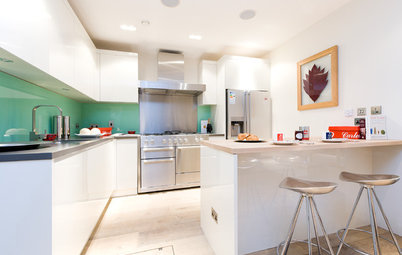
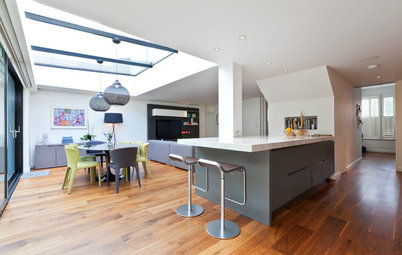
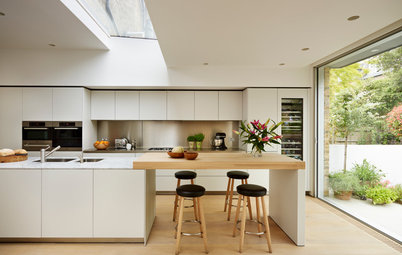
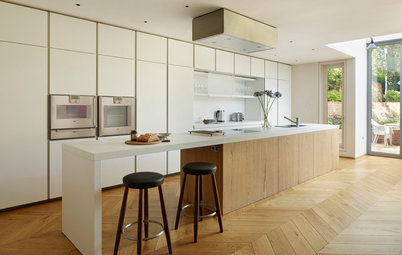
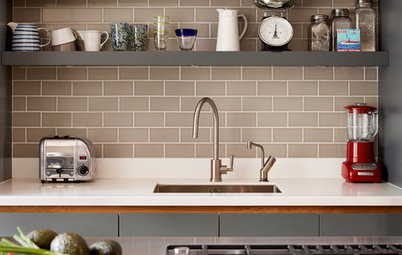
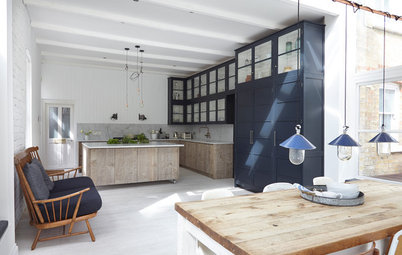
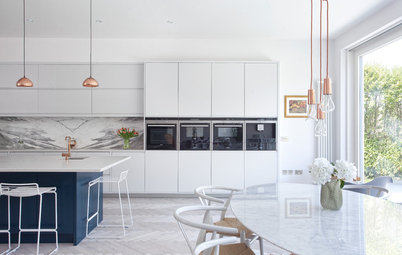
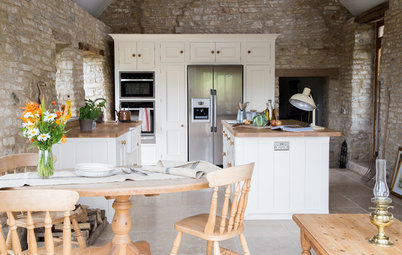
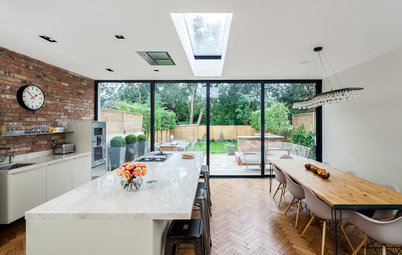
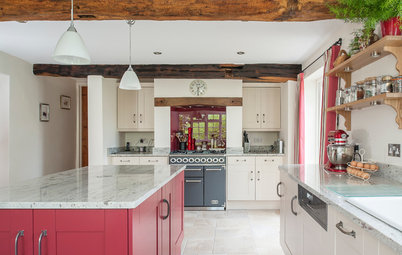

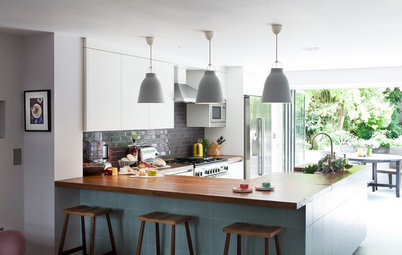
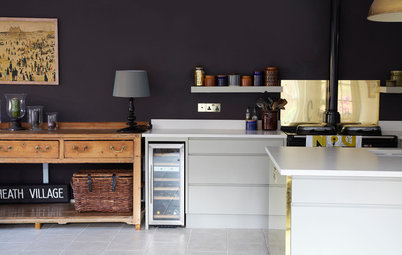
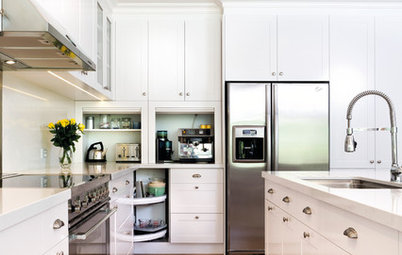
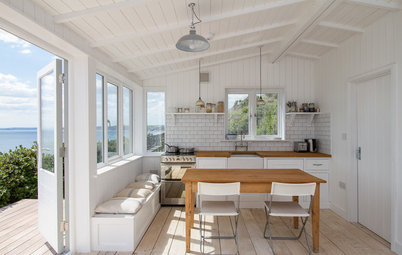

There are three main ways to fit a sink into your worktop – undermounted, top-mounted and integrated. Here’s a rundown of the options.
Undermounted
For a sleek look, go for an under-mounted design. These sinks are fitted below the worktop, with the rim concealed, leaving no edges on show.
Pros With no exposed rim to trap food, an undermounted sink is a great option if you want something that’s easy to clean. They don’t take up space on the worktop and they provide a streamlined, minimalist aesthetic.
Cons As the sink will usually be hanging below the worktop, you’ll need a surface that’s both strong and water-resistant. It’s also important to hire a professional fitter who can ensure your sink is well-supported and doesn’t leak.
Find kitchen designers and fitters in your area.